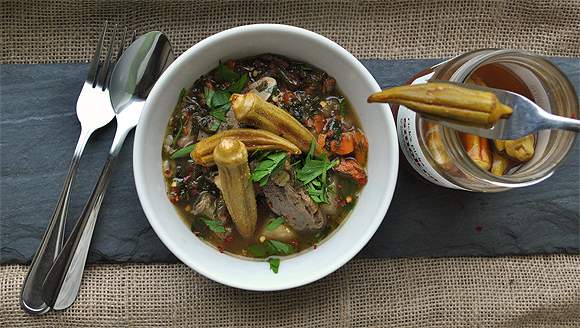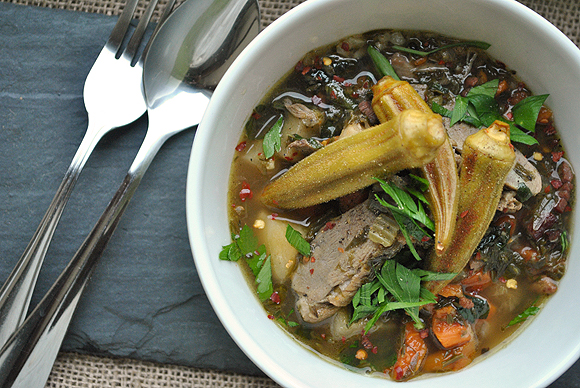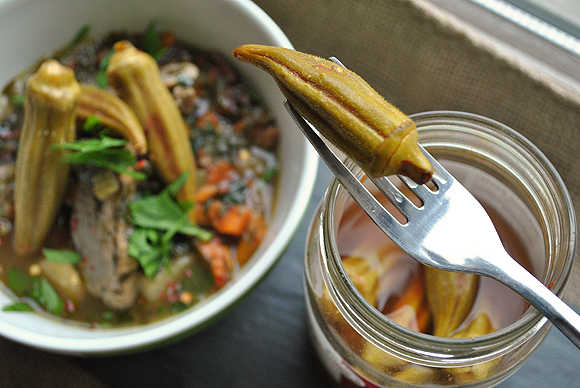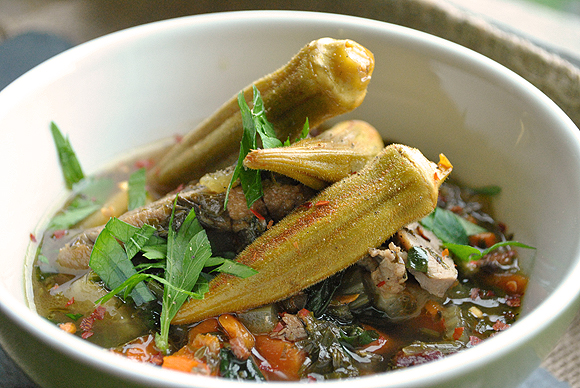
Often when we think of Southern Soul food, we think of mac and cheese, fried chicken, collard greens, and potato salad–to name a few dishes. In reality, it’s about the first animal shot in the morning and served in a stew in the evening. Depending on the size, it’s served in various forms within the next few days. Bellies are salted and cured for preservation (Read: Bacon). Bones, such as poultry backs with little meat, are used for broth. Inners are fried to a crisp or simmered in broth. Fat is rendered into lard for baking or frying. Brains are served in rich root vegetable gratin dishes freshly made with butter, cream or buttermilk (that generation wasn’t lactose-intolerant). Generations ago, our grandparents feasted on wild possums, doves, turtles, squirrels, rabbits and deer. As Craig Samuel, co-owner of Peaches Restaurant in Brooklyn, mentioned, “…it’s the food that kept our grandmothers…[and families] alive…”

A high school history teacher said during the 1930’s Depression, there was a joke about Southern Blacks not really starving because they knew how to skin a rabbit. The irony of the whole “head to tail” trend, in which food activists glorify the eating of a whole animal, is its occurrence paralleling (is it past or current?) recession. The return to eating produce straight from farms by joining Community Agricultural Shares (CSAs) and shopping at Farmer’s Markets are reflective of an agricultural lifestyle of the past, in which many people of that time period were poor.
When I first started MyLifeRunsOnFood.com, my idea about Southern Soul food was the same as most people’s romanticized version, and I’m still learning about it. Especially, as I recall how my father talked about Pig’s Head cheese and venison chili he enjoyed eating as a child visiting relatives in Alabama. Let’s be honest, I have an uneasy feeling over the thought of eating most–if not, all–wild animals. I remember yelling, “ewww” to Dad’s stories about hunting and eating wild game. After all, I am two or three generations removed from agricultural living. Today, most people who grew up eating wild animals don’t speak of it, because it’s a taboo subject. Such dishes are considered poor, country food. However, yesterday’s poor, country food of our Great Grandparents who grew up in poverty are appearing on today’s trendy restaurants–with few acknowledging its Southern African-American source.
My northern bred boyfriend comes home with The Dooky Chase Cookbook, a generous Thank You gift from the Director of A Streetcar Named Desire, in which he’s part of the ensemble cast. He excitedly asks for a real Southern meal. He claims it’ll help with his background research about his character in New Orleans. Never mind, he plays Pablo, a Spanish or Hispanic role, who would probably prefer a rice and bean dish.
Reviewing Dooky Chase’s cookbook, I found familiar recipes for Sweet Potato biscuits, Shrimp and Grits, and various Gumbo stews. Squirrel Pie, Giblet Stew, Stewed Snapper Turtle, Stewed Tripe with Pigs’ Feet, and Beef Tongue in Brown Gravy are a few examples of wild game recipes from her book. In the end, I decided to make a southern dinner of Duck and Turnip stew with Dandelion greens, garnished with Ricks’ Picks Pickled Okra. The following recipe is a revised version from Chase’s cookbook, but it’s richer with the addition of herbs, duck bacon, diced vegetables, homemade chicken broth and wine.

Luckily, I ran into Samuels, who advise me not to stew a whole duck as Chase directed. He shares his process of how to cook a whole duck in a stew. For the faint of heart and to save time, he suggests purchasing a bag of duck legs instead of a whole duck (and skip steps 8 and 9 in the recipe below) the next time the stew is made. Also, he recommends adding star anise and one quick zest of an orange to open the duck flavor.
In talking with Samuels, we talked about how important our generation reclaim their true Southern roots about food. For those of us with Southern American roots, we need to start asking our grandparents (or great grandparents) about their everyday life of growing up on farms. They’re a genuine source for improving our knowledge about real food. Our grandparents’ diets were similar–if not better–than today’s food labeled as organic, grass-fed, free-range, preservative and artificial dye free, and homemade. While today’s “head to tail” food trend is being glorified by the elite, I know such dishes were yesterday’s survival food of my ancestors.

Duck and Turnip Stew with Dandelion Greens
» Recipe adapted from The Dooky Chase Cookbook with advice from Craig Samuel of Peaches Restaurant in Brooklyn, NY
» If you can find it, serve with Dandelion Wine (find the recipe in Edna Lewis’ The Taste of Country Cooking.
Ingredients
Olive or Peanut oil, as needed
8 oz. duck, turkey or pork bacon, diced
1 whole duck (or if using a bag of duck legs, omit steps 8 and 9)
32 oz. chicken or duck broth; more or less to cover the vegetables and meat in the pot
3 large turnips; peeled and diced into ½ inch pieces
1 large onion, diced
1 bunch carrots, diced
3 to 4 celery stalks, diced
4 garlic cloves; minced
½ tsp. smoked paprika
Sea salt and fresh black pepper; as needed
1 cup white or dandelion wine
1 bay leaf
1 whole anise
2 whole dried red chili peppers
(optional) 1 zest of orange
1 bunch of thyme tied with twine
1 cup minced fresh Italian parsley
1 bunch of fresh dandelion greens; thoroughly cleaned like collard greens and roughly chopped
Garnish: Pickled vegetables, such as okra and cooked wild brown rice
Directions
1. If blessed with skills to chop a duck into pieces, go for it. If not, ask a butcher to chop it into 2 legs, 2 wings (throw away the third part or save for homemade stock), the back cut into two parts, and 2 breasts (Request the breast meat be removed from the bone). Once home, clean the pieces. Rub with olive oil, sea salt, fresh black pepper, crushed red pepper, and two cloves of minced fresh garlic. Let marinate for at least three hours or overnight. Place aside.
2. Bring broth to a simmer in a medium pot. Turn off heat and set aside.
3. In a large pot, heat 1 tbsp. of olive oil over medium-high. Add duck bacon to the pot. If necessary, empty excess fat into a container.* When bacon is crispy, remove onto a paper towel lined plate. Place duck fat and bacon (separately) aside.
4. Working in batches (don’t overcrowd the pot) over medium heat in the same pot as the duck bacon, brown both sides of the duck legs, wings and back (Note: The back is for flavor, be careful not serve it when the stew is complete). Set the duck breast aside. Remove pieces to a paper towel lined plate. Set aside. (Note: Occasionally, empty excess fat into the same container as the duck bacon fat and set aside*).
5. Add chopped turnips to the pot. If the pot is too dry, add a little of the duck bacon fat. Caramelize all sides to golden brown. Remove to a paper towel lined plate. Set aside.
6. Add onions, carrots, celery, garlic, sea salt, fresh black pepper, and smoked paprika. If the vegetables seem a little dry add a little duck fat or a tablespoon of broth.
7. When the vegetables start to soften, add the warm broth, wine, bay leaf, anise, chili peppers, orange zest (optional), thyme bunch, and parsley. Partially cover and bring pot to a slow slimmer. Cook for about 1 hour or until the duck is thoroughly cooked. Occasionally, adjust the seasoning.
8. Meanwhile, finely slice the fat of the duck breast, being careful not to cut into the skin. The skin should have a crisscross pattern with lines a quarter inch apart to help release excess fat when the breast is seared.
9. Heat a black skillet over medium-high heat. Do not add any oil, because the duck breast has lots of fat. Add the breasts, fat side down to the skillet. Using a heavy object to apply pressure to the duck breast (Use a heavy brick wrapped in foil or a smaller heavy pan topped with canned goods). Cook the breast to a golden brown. Occasionally, empty excess duck fat into a proper disposable container to prevent the ‘liquid fat’ from steaming the breast (an undesired result). After about 3 to 4 minutes, flip the breast over to sear for another 2 to 3 minutes (vary this time based on a personal preference for wellness of meat). Remove breast to a paper towel lined plate. Quickly season with salt and pepper. Let the breast rest on a paper towel lined plate and thinly slice.
10. Ten minutes before the stew is done, return the turnips to the pot.
11. When the stew is done, turn off the heat and add half the duck bacon.
12. Ladle soup into individual bowls. Generously garnish with dandelion greens and duck breast slices. Sprinkle duck bacon on top of the bowl. Serve with wild brown rice and pickled vegetables. Adjust seasoning.
13. Enjoy.
*Note: Save excess duck fat to use in a roast or saute vegetable recipe.

Wonderful post Sanura! And so true. Our grandparents and great grandparents were the pillar of health eating all-natural and “organic” whole foods, because they were the only foods available. I’m not so sure that I’m completely down with the head-to-tail philosophy (just yet, still a bit icky lol) but definitely looking forward to learning more about the foods and preparation styles our previous generations exercised. 😉
What a wonderful surprise!! Your blog is apart of my morning tea and food blog check ins before work sets in :). How great to see my favorite pickle SMOKRA (I work with Rick’s Picks) with my favorite discussion, Southern Foods (I’m originally from Charleston)! May we (Rick’s Picks) link to your post and retweet?
Sanura, your point of view and recipes are always original and inspiring!! I always look forward!!
This is very very interesting. I am african and i stay in africa and what intrigues me the most is that some of the ingredients used in this particular dish and other dishes that you mentioned are the things enjoyd by most traditional african folks.
thank you for acknowledging and appreciating your african roots